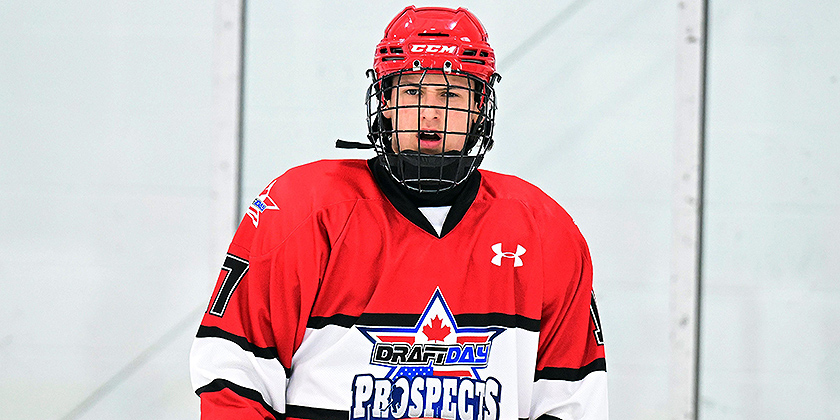
Tanner Adams (RW, R, 5’11”, 197, Providence College, 09/02/2005, Providence)
Tanner Adams is a high-motor, right-shot winger with NHL-caliber compete level, above-average hockey sense, and situational awareness that makes him a trustworthy piece in all three zones. He’s played this season in a middle-six role for Providence, earning power play time but surprisingly limited exposure on the penalty kill, which is where he likely projects best as a pro. Despite a modest statistical profile, Adams’ leadership, anticipation, quickness to space, and ability to make the simple, correct play under pressure give him the foundation of a bottom-six energy winger with upward mobility if he can continue to develop certain parts of his offensive toolkit.
Why He Should Be an NHL Draft Pick:
- Intelligent, Pro-Style Game Awareness:
Adams excels in subtle areas that matter at the NHL level—staying on the defensive side of pucks, maintaining proper spacing in support of puck battles, and timing his entries and zone transitions with purpose. Coaches trust him, and that’s one of the biggest early boxes to check for bottom-six NHL projection. Adams earns his points through consistency and function, not flash. - Strong Anticipation and Puck Retrieval Habits:
His 1.71 loose puck recoveries per game and 3.1 takeaways per game are strong indicators of his game processing and ability to read plays as they develop. He picks off passes, wins races using his quick first three steps, and stays active on the forecheck. He doesn’t cheat for offense, and he plays with structure, which aligns well with the identity of a checking winger in the NHL. - Physical Competitiveness and Forechecking Impact:
Despite being slightly below average NHL size (5’11”, 197 lbs), Adams plays with a physical edge—1.16 hits per game—and is not shy about engaging defenders on dump-ins or inside tight spaces. He uses leverage well (notably in puck battles), often winning position and protecting pucks using his hips and body angle. He’s also unafraid to take hits to make plays and draws respect from opponents with his effort.
Why He Might Not Be an NHL Draft Pick:
- Lack of PK Role in College is a Red Flag for NHL Projection:
Adams averages just 0:24 per game on the penalty kill, which is a concern given his likely fit at the next level as a checking line player. For a forward without top-six offensive upside or top-end skill, he must become a reliable penalty killer to stick. Whether this omission is coaching choice or skill-set limitation is unclear, but it’s something National League teams will want more clarity on. - Inconsistent Puck Management and Low-End Offensive Ceiling:
His 4.9 giveaways per game are too high for a forward who doesn’t carry the puck often, and his 85% pass success rate combined with a 45% puck battle win rate underline limitations in handling heavy pressure. He struggles to extend possession when the pace ramps up, and while he has a strong work ethic, there’s no real evidence of play-driving ability. His shot mechanics also need work: just 10% conversion on 1.61 grade “A” chances per game and too many attempts being blocked (0.76) or missing the net (0.89) are holding back his production. - Tweener Physical Profile with No Defining Trait:
At 5’11”, 197 lbs, Adams is caught in the middle—he’s not big enough to intimidate, nor skilled enough to play above the third line. While he checks a lot of “high-compete” boxes and plays the right way, his path to the NHL is narrow. He’ll need to become an elite penalty killer or find a niche on energy lines as a low-event forward to have staying power.
Projection:
Bottom-six energy winger and situational penalty killer with fringe offensive upside. Most likely projection is as an AHL/NHL tweener early in his career who becomes a dependable fourth-line option if his shot mechanics, PK detail, and physical strength improve.
Draft Recommendation:
Late-Round (7th Round) Grade – College Free Agent Candidate
Adams’ compete level, intelligence, and translatable habits give him a chance to grind his way into a bottom-six NHL role, but he’ll need continued development and special teams versatility to earn a contract. If passed over in the draft again, he’s the type of college free agent a smart organization should track through his junior/senior year.
Photo credit: Dan Hickling/Hickling Images
